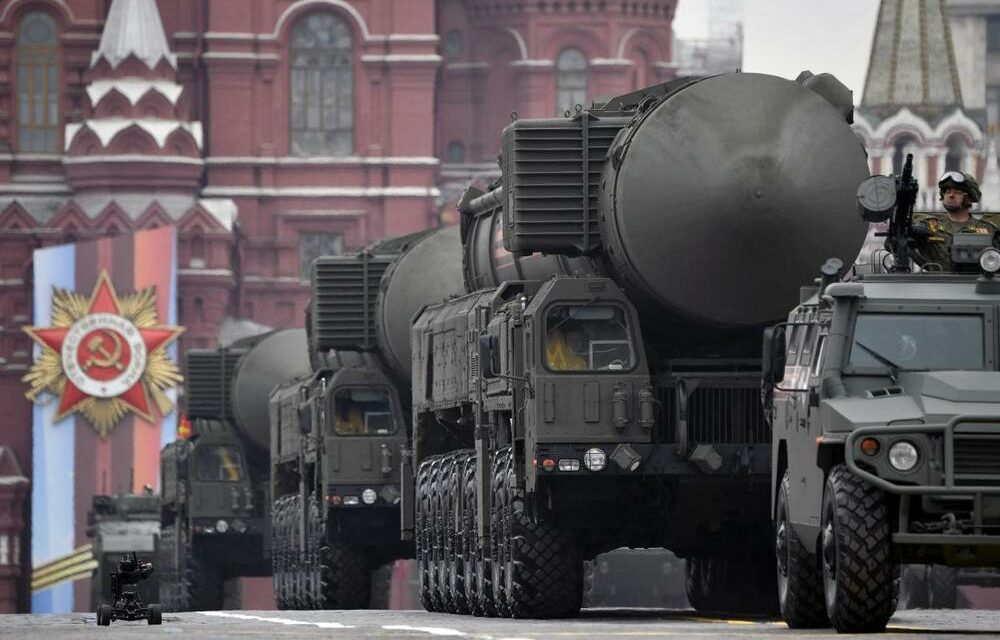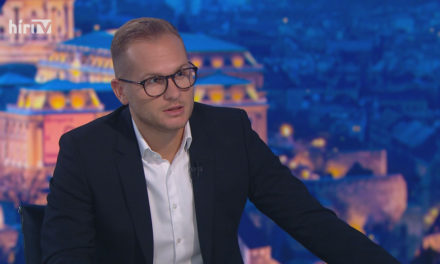Tank battles in Europe, energy and food crisis, atrocities and refugees. If this is what history looks like when it ends, what can await us when it whistles and starts moving again? However, all these concerns are dwarfed by the elephant "I would stumble into the small room, it flew towards me". And this elephant in our room is none other than the Russian nuclear threat - read Robert C. Castel's analysis of the Russian-Ukrainian war on the neokohn.hu website .
The most worrying thing about this whole nuclear saber rattling is that everyone is aware of the asymmetry of the relationship between the two camps and our resulting helplessness.
During the Cold War, the principle of mutual assured destruction provided a credible deterrent: We are willing to sacrifice New York to avenge Paris. However, in the current situation, even the most saber-rattling pacifist of yesterday is aware that not only will we not sacrifice Paris for Bilhorod-Dnistrovskyi, but we will not even sacrifice Pornóapaty.
This fact makes us quite blackmailable and the Russians, who are perfectly aware of this fact, love to pull out the nuclear thumbtack again and again. Since an anxious electorate does not bode well for votes, Western politicians have had to find ways to somewhat allay public concerns. Naturally, they turned to the experts for a solution.
Nuclear placebos
At first, the fact that very few experts have dealt with nuclear strategy in recent decades caused some problems.
What would they have done it for? As we learned from Francis Fukuyama, history ends anyway, and at the end of the movie, no one goes out to the cafeteria for popcorn. Fortunately, TV cameras attract experts like storm lanterns attract moths, so after a short search, the studios were populated. The sedatives prescribed by politicians for the public and concocted in the witches' kitchens of well-paid experts had all the mandatory components of quality placebos:
- the relevant charms of international law on the wrapping paper
- the moral sugar coating
- the filling, which replaces the active ingredient
The placebo filler mentioned above usually comes in two types of packaging.
The first version is based on game theory and the mathematical models that form its core propagate a very original and creative theory that the dog that barks does not bite.
The second version approaches the problem from a historical perspective and points out that nuclear powers have lost wars in the past, but still did not use nuclear weapons. Based on this, the experts stated that, knowing the historical pattern, we can say with great certainty that there is no need to worry. Russia will not use nuclear weapons in Ukraine.
The fact of the seven decades of nuclear silence is indisputable, but the relevance of the historical experience is highly debatable. Have we really been in a similar situation in the past, or is it a completely new line-up? Does the historical pattern mentioned by the experts really exist, or is it all just the embryo of a well-sounding but empirically unproven theory? Why is it important to give a well-founded answer to this question? This is because this sedative prescribed for internal use also defines our foreign and security policy.
Among other things, the level of risk that can be assumed vis-à-vis Russia. If the experts are wrong, then the risk-taking indicator of our current policy has been oscillating in the red zone indicating danger for a long time, without us even knowing it.
The purpose of this article is to empirically analyze the nearly 150 wars that nuclear powers have fought since the dawn of the nuclear age, to take a closer look at the lost wars, and to reflect on the lessons of these patterns for current Russian nuclear threats.
One and a half hundred wars of the nuclear powers
In order to at least try to say something substantive from this approach, there is nothing else left but to collect all the relevant cases: wars fought by nuclear powers. If we don't learn this rather gray, woodcutter's job, we will forever remain at the level of anecdotes and "common knowledge" findings.
What is common knowledge about nuclear wars?
- The fact that they always lose them, because of course Vietnam, Afghanistan and then Afghanistan again, only this time in the colors of a different team.
- The Americans are more accomplished than the Russians because they have lost more wars.
- Guerrilla David always defeats nuclear-armed Goliath.
Don't laugh at this, and especially don't underestimate the power of anecdotal knowledge. Most of the time, experts also draw on such anecdotal knowledge when a reporter points the microphone at their throats. Only in a tiny percentage of cases do we have up-to-date, relevant and verified research results. For this reason, it is worth treating all expert opinions with a good dose of skepticism, including the explanations of the author of these lines. And for those whose answer is that we should expect something else from pseudosciences such as social sciences, I can reassure them that their cardiologist makes his diagnoses in a similar way.
Returning to the woodcutter's work, let's perhaps start with who are these nuclear powers?
There are currently eight declared nuclear powers: the US, Russia, China, the UK, France, India, Pakistan and North Korea. These eight states share a significant part of the world's 13,000 nuclear charges. Why did I include this "significant" escape between the lines? This is because there are other states that presumably have their own nuclear arsenal, but due to the uncertainty factor, we are not dealing with them here and now.
Since the analysis is limited to the wars of the nuclear powers, only those wars that were already fought with nuclear weapons are included in the "shopping basket". This dividing line is drawn differently on the wall calendar for each state. The United States of America crossed the nuclear threshold in 1945, the Soviet Union in 1949, and the United Kingdom three years later. France joined the club in 1960, China in 1964, India ten years later, and Pakistan in 1998. North Korea closes the series with its first nuclear explosion in 2006.
Is there anything left in the "shopping cart" after removing the non-nuclear wars? Left. It's not even enough.
Since the dawn of the nuclear age, the world's nuclear powers have fought 146 wars.
Some of them have not been closed to this day as an ongoing conflict. This means that the current Russian-Ukrainian war, which is the aggression of a nuclear power against a state that does not have nuclear weapons, is by no means a unique and blatant event. It is a kind of conflict, of which the world has had an average of two per year since the end of the Second World War, even if the vast majority of them never reached our stimulus threshold. Since the number of cases is quite significant, and since the current Ukrainian crisis fits perfectly into the examined category, it is worthwhile to continue the questioning.
Is it possible that the majority of these wars are being fought by a single, global Strong Pista?
The answer to that is no. Not even if our politically motivated stereotypes rebel against the tyranny of facts. The figures show that Russia, the USA and France, which is regarded as a pillar of the pacifist EU, share the first place on the podium of fighting spirit. On average, this trio goes to war every two years. The second place, also shared, goes to the saber rattling Albion, tied with India, famous for Gandhi's rejection of violence. On average, they go to war every three years. The third place belongs to China, with its wars every four years. Pakistan goes to war on average every six years. And North Korea, despite the ballistic riots it incites, judging by the data, is so peaceful that even a rabbit can boldly chase it. On average, it goes to war every eight years.
Yes, some will say, but there is a difference between war and war. The current crisis in Ukraine cannot be equated with a guerrilla war in Southeast Asia. This is a completely valid statement, which is why it is worth dividing the examined wars into two groups:
1. for conventional wars like the previous example, and
2. for low intensity conflicts like the latter.
Looking at things from this angle, the only discernible pattern is a stark difference between the former colonial states - including Russia with its home "colonies" - and the rest. The former group mostly fights low-intensity wars in their former colonies, the latter mainly fights conventional wars.
Another interesting question - which directly follows from the previous question - concerns the geographical distribution of wars. A few surprises await us here as well. The shock following the Russian aggression and the mourning of the lost times of peace in Europe are understandable, but not well-founded.
Europe never became a continent of peace, even in the nuclear age.
These wars were not limited to the Balkans and the Caucasus, but were also present in the western part of the continent, just think of the Basque, Corsican and Irish conflicts.
The palm of the Continent of Peace is taken by the Western Hemisphere
The nuclear powers have fought more than three times as many wars in Europe as in North and South America combined.
Another rather surprising figure shows that the nuclear powers have fought almost twice as many wars in Asia as in Africa.
Speaking of the geographical variable, it is worth distinguishing between domestic and expeditionary wars. Unsurprisingly, maritime powers, and those with extensive overseas colonies in the past, fight mainly expeditionary wars far from their borders. In contrast, land powers most often fight domestic wars, often within their own borders. Why is this an important aspect? Because
the calculus of a losing war fought at the other end of the world is completely different from one that takes place within our borders or within them.
Since 1945, the USA has fought five wars in the Western Hemisphere, of which it lost only one: an intervention against Cuba in which it was not officially involved. France and the United Kingdom lost quite a few expeditionary wars, but emerged victorious from European conflicts. The performance of the most interesting player for us, Russia, also shows a similar pattern.
As a land power, the Soviet Union/Russia fought most of its wars along its borders or not too far from them.
Only a third of the wars he waged can be considered expeditionary wars. He lost a considerable part of them, such as the 1967-1973 intervention against Israel, or only managed to draw, such as the Eritrean adventure. As for the 19 civil wars he fought, the vast majority of them were won by the Soviet Union/Russia. This applies to both conventional wars and low-intensity conflicts.
Here we have reached the point where it is possible to try to draw certain conclusions from the historical patterns of the nuclear powers, especially Russia — regarding the outcome of the Ukrainian war and the chances of nuclear escalation.
Pessimistic patterns
After the Soviet nuclear test in 1949, the Russian bear participated in 28 wars. Of these, he won 71%, lost 14%, while the remaining 15% ended in a draw or are still unconcluded. Like the other nuclear powers, it won its domestic wars with very few exceptions, 84% of the time. This is bad enough news in itself.
At the same time, it is important to remember that there is nothing deterministic about wars and there is no rear-view mirror or crystal ball. It is quite possible that the current war in Ukraine will end in a draw or even a defeat for Russia. That's why
it is worth examining what were the historical consequences of the Russians' losing domestic wars.
As a result of the First Chechen War (1994-1996), the territorial integrity of the Russian Federation was damaged and a general disintegration became a real threat. The domino effect of the lost war immediately affected other areas of Russia that cherished separatist dreams. It is also worth mentioning that the current status of the Chechen Republic as a member republic is only a legal fiction that serves as a disguise for the territory's de facto independence. A fact remains a fact. With the lost war, not only a historical territory was lost, but also the cohesion of the Federation was shaken.
The other losing war, the Afghan adventure of 1979-1989, had even more dramatic consequences. The fiasco in Central Asia played a decisive role in the collapse of the Soviet Union and the loss of the sphere of influence gained in the Second World War. The best indicator of what all this means for the current Russian political elite is President Putin's speech in 2005, when he called the fall of the Soviet empire the greatest political catastrophe of the century.
What does all this mean in relation to the further development of the war in Ukraine and a possible nuclear escalation?
It means that whether or not Russia wants to let go of the mad ax is completely beside the point. The real question is whether he will be able to do this without jeopardizing the cohesion of the federation and the survival of the regime, based on the experience of two lost civil wars. This is the true measure of the application threshold of the Russian nuclear doctrine, and
we can reach this threshold even if not a single NATO boot crosses the border of the new Iron Curtain.
If we do not formulate our policy taking into account the perceived and empirically verifiable Russian concerns, but based on superficial findings that "nuclear powers have lost wars on other occasions and yet have not reached for nuclear weapons", then it is possible that the drowning will drag us into the vortex of nuclear escalation.
Source: neokohn.hu / hirado.hu
Cover photo: AFP / Europress / ALEXANDER NEMENOV












